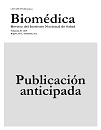Phlebotomine (Diptera: Psychodidae) species and their blood meal sources in a new leishmaniasis focus in Los Montes de María, Bolivar, Northern Colombia
Abstract
Introduction. In 2018, El Alférez Village in Los Montes de María (Bolívar Department-Northern Colombia), macro-focus of leishmaniasis, recorded its first case, highlighting changes in the distribution and eco-epidemiology of the disease, although interactions between vectors and local fauna remain unknown.
Objetive. To evaluate the diversity of sandflies and their blood meal sources in the community of El Alférez, El Carmen de Bolívar (Department of Bolívar-Colombia).
Materials and methods. Sandflies were collected in 2018 using LED-based light traps in domestic/peridomestic/sylvatic ecotopes and identified at the species level. Multiplex PCR targeting the mitochondrial Cytb gene was used to analyse blood from the digestive tract.
Results. Lutzomyia evansi was the most abundant species (71.85%-n=485/675), followed by Lutzomyia panamensis, Lutzomyia gomezi, Lutzomyia trinidadensis, Lutzomyia dubitans, Lutzomyia abonnenci and Lutzomyia aclydifera. 25.00% (n=25/100) of the species analyzed showed bloodmeals from Canis familiaris (36.00%-n=9/25), Ovis aries (36.00%-n=9:/25), Bos taurus (24.00%-n=6:/25), Sus scrofa (20.00%-n=5:/25) and Homo sapiens (8.00%-n=2/25). Lu. evansi was the species with the highest feeding frequency (68.00%-n=17/25), predominantly on a single species (44.00%-n=11/25) or a combination of different species (24.00%-n=6/25).
Conclusion. Results indicate eclectic feeding behaviour in Lu. evansi, implying potential reservoir hosts for Leishmania spp. and increasing transmission risk. This study is a first step towards understanding the diversity of mammalian blood sources used by the sandflies community. This is crucial for vector identification and the formulation of effective control measures.
Downloads
Copyright (c) 2024 Biomedica

This work is licensed under a Creative Commons Attribution 4.0 International License.
| Article metrics | |
|---|---|
| Abstract views | |
| Galley vies | |
| PDF Views | |
| HTML views | |
| Other views | |


























